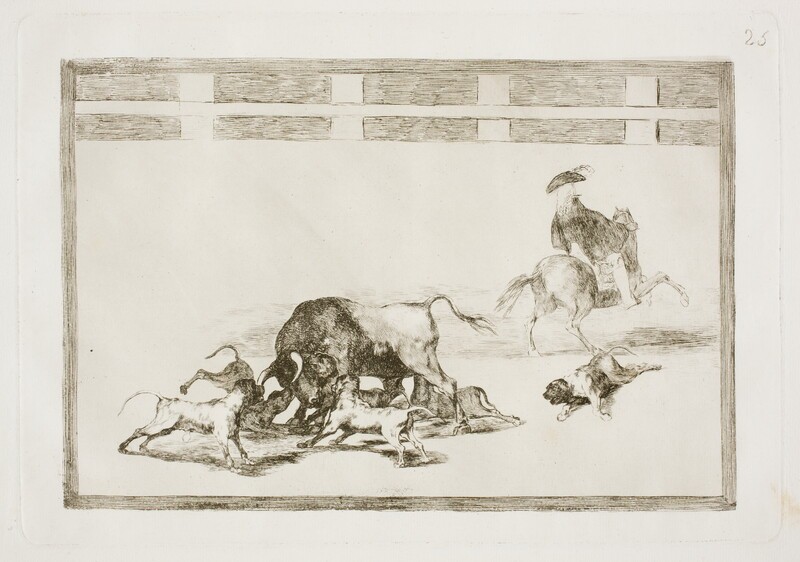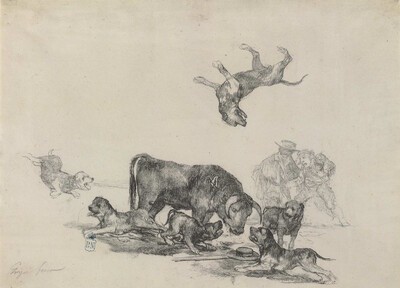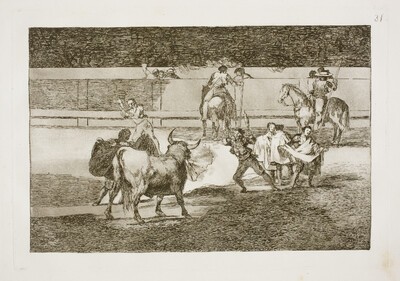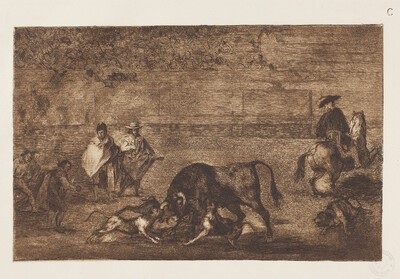- Cronología
- 1814 - 1816
- Dimensiones
- 245 x 353 mm
- Técnica y soporte
- Aguafuerte, aguatinta, punta seca y bruñidor
- Reconocimiento de la autoría de Goya
- Documented work
- Ficha: realización/revisión
- 02 Oct 2021 / 22 Jun 2023
- Inventario
- -
25 (print, upper right-hand corner)
See How the ancient Spaniards hunted bulls on horseback in the countryside
A state proof has been preserved before aquatinting.
The plate is preserved in the Calcografía Nacional (no. 358).
See How the ancient Spaniards hunted bulls on horseback in the countryside.
This picture depicts a striking practice, now in disuse, typical of the bullfights of Goya's time, in which the bull that proved to be unfit for the fight in the ring was released with dogs to immobilise him and facilitate the performance of the puntillero, who proceeded to stick the spike between his horns to put him to death.
We see the bull wrestling with five dogs in the middle of the ring, plus another dog that seems badly wounded and is crawling on the ground. Meanwhile, a uniformed man on horseback, a bailiff, turns his back to us and rides off into the distance. We can partially see the barrier that delimits the space, but not the public, as Goya draws the viewer's attention to the main event, the confrontation between the bull and the dogs, preventing him from being distracted by other matters.
The print is thematically related to another that Goya eventually discarded, Dogs at the Bull (Bullfighting C), which reflects the same type of action.There is also a Goyaesque lithograph, entitled Bull harassed by dogs, which also shows this unique bullfighting practice, which was eventually replaced by the use of fire flags. . In turn, the work is linked to a drawing by Goya that also depicts violent harassment by a pack of dogs, although not a bull but a cat and a man on a donkey: Man on a donkey, with a cat on his head, pursued by dogs (F.39).
Glendinning emphasises the harshness of the scene, while Martínez-Novillo, for his part, points out that Dogs at the Bull (Bullfighting C) would be a discarded version of the print in question, which he places in the category of those showing impersonal suertes, linking it, in his opinion, to Fire flags
There is a preparatory drawing of this engraving, also titled Dogs are thrown to the bull.
-
Grabados y dibujos de Goya en la Biblioteca NacionalBiblioteca NacionalMadrid1946catalogue Elena Páez Ríos
-
Goya en la Biblioteca Nacional. Exposición de grabados y dibujos en el sesquicentenario de su muerteBiblioteca NacionalMadrid1978May - June 1978
-
Grabados de Goya: colección propiedad de la Biblioteca Nacional, que se conserva en su Gabinete deCasa de la Amistad de MoscúMoscow1979exhibition displayed from January 18th to 31st 1979
-
1984
-
Madrid1987
-
Madrid1990
-
Goya grabadorFundación Juan MarchMadrid1994consultant editors Alfonso E. Pérez Sánchez and Julián Gállego, from January 14th to March 20th 1994
-
Goya grabadorMuseo del Grabado Español ContemporáneoMarbella1996from March 8th to May 5th 1996
-
Zaragoza1996
-
Schlaf der Vernunft. Original radierungen von Francisco de GoyaMunich2000
-
Madrid2002
-
Madrid2002
-
Bilbao2012
-
Zaragoza2017
-
1946pp. 177-216, espec. p. 202
-
BarcelonaTartessos-F. Oliver Branchfelt1946 (reed. 1951)
-
OxfordBruno Cassirer1964vol. II, 1964, p. 341, cat. 228
-
Vie et ouvre de Francisco de GoyaParísOffice du livre1970p. 279, cat. 1200
-
MilwakeeMilwaukee Art Museum1986pp. 16, 19, 25 y 32
-
Goya, toros y torerosMadridMinisterio de Cultura, Comunidad de Madrid1990p.108, cat. 40
-
MadridCaser-Turner1992p. 36
-
Catálogo de las estampas de Goya en la Biblioteca NacionalMadridMinisterio de Educación y Cultura, Biblioteca Nacional1996cat. 349
-
MadridMuseo Nacional del Prado2001pp. 83-85
-
Goya. In the Norton Simon MuseumPasadenaNorton Simon Museum2016pp. 186-201





